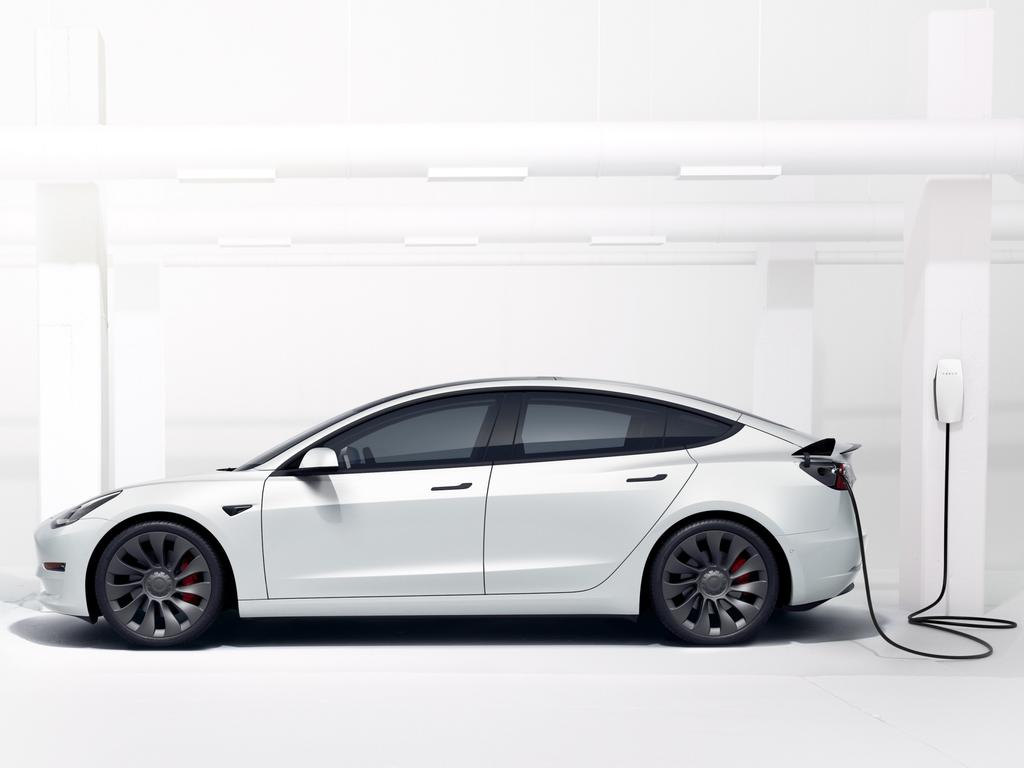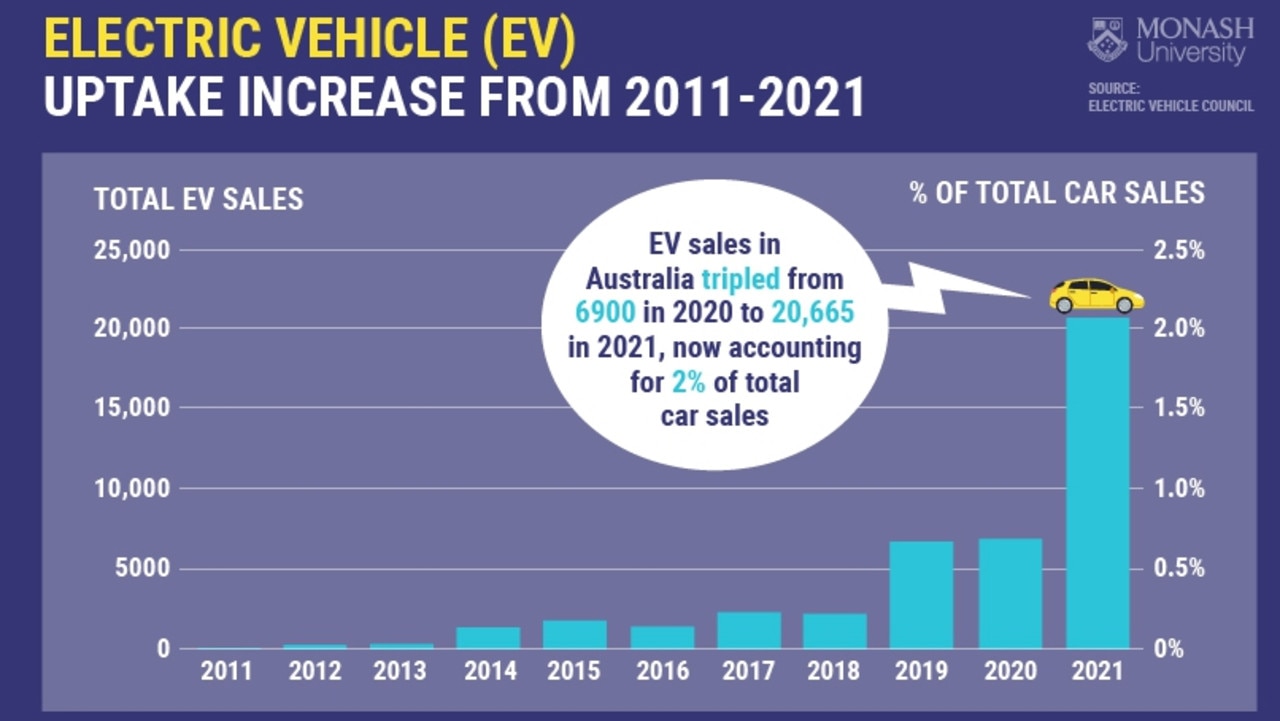The 12,000km tipping point: When an EV becomes the cheaper choice
We have crunched the numbers to show at what point it becomes cheaper to buy an EV rather than a petrol car. See the results.
National
Don't miss out on the headlines from National. Followed categories will be added to My News.
With petrol prices about to jump about 25 cents a litre, more Australians are considering the potential cost benefits of ditching their fuel-thirsty cars.
Our calculations show drivers who travel as little as 12,000km a year could be able to save money by making the switch to an electric vehicle.
THE RISE OF EVS
An exclusive brief prepared for News Corp by Monash University’s Climate Change Communication Research Hub reveals the popularity of electric vehicles (EVs) has surged in the past two years, with EV sales tripling from 6900 in 2020 to 20,665 in 2021.
This includes both Battery Electric Vehicles (BEVs) and Plug-in Hybrid Electric Vehicles (PHEVs).
August was a record-breaking sales month, according to the Federal Chamber of Automotive Industries.
Tesla alone sold 3397 vehicles in Australia.

“In the month, EV sales were 4.4 per cent of the total market,” FCAI chief executive Tony Weber says.
“This is the highest market share for pure battery electric vehicles ever recorded in a single month in Australia.
“Year-to-date, EV sales are 2 per cent of the total market, hybrids are 7.6 per cent and plug-in hybrid vehicles are 0.6 per cent.
“Combined, electrified vehicles are now just over 10 per cent of total sales in 2022.”
Despite the significant increase, however, Australia’s uptake is still modest when compared globally.
For example, BEVs and PHEVs represent about a 6 per cent market share of all car sales in China, 11 per cent in the UK and 74 per cent in Norway, according to the Monash report.
The main factors holding Aussies back are perceptions of high purchase costs, low supply and uncertainty around battery reliability between charging points – often referred to as range anxiety.
To address the first concern, we have crunched the numbers to see if the extra upfront cost could be worth it.
THE MATHS
The most affordable BEV in Australia is the MG ZS EV Excite sport utility vehicle, with a 2022 model priced from $45,000 drive-away.
The top-selling non-electric SUV, for comparison, is the Mazda CX-5 Maxx (FWD), which starts at about $32,000.

Assuming a person holds onto their car for 10 years – the average age of Australia’s vehicles, according to the Australian Bureau of Statistics, and the average life of an EV battery – the running cost of the MG would need to be $1300 a year less than that of the Mazda to break even over the life of the car.
As of tomorrow, the federal budget’s fuel excise will return to its full rate, so petrol stations will begin passing on the extra 25.3 cents per litre to consumers.
Australian Institute of Petroleum reports the average petrol price across Australia last week was 173.9 cpl, meaning it is likely to hit about 199.2 cpl when the excise is reinstated.
At 199.2 cpl, and given a Mazda CX-5 Maxx typically consumes 6.9L of petrol every 100km, the petrol SUV would cost $13.74 per 100km to drive.
The price of charging the MG, on the other hand, is much lower.
Charging station company Jolt reports a cost of between $0.15 per kWh and $0.60 per kWh, depending on the type of charger.
With the MG’s 44.5kW/h-capacity battery and 263km range, it would cost between $6.68 and $26.70 for a full charge, or between $2.53 and $10.15 per 100km of driving.
So for a person who drives 12,000km a year, they can spend about $1649 on petrol for a Mazda CX-5 Maxx or $304 on electricity for an MG ZS EV (sticking to the more affordable charging stations) and break even over 10 years of car ownership, gradually making up the initial price difference between the two cars.
| Annual cost of running a car – electric (MG) v. petrol (Mazda) | ||||
| KM/YR | MG ZS EV | Mazda CX-5 | Annual difference in running cost | Difference over life of car [$13,000 difference in purchase price – (10 x annual difference)] |
| 10,000 | $253.00 | $1,374.00 | $1,121.00 | $1,790.00 (i.e. cheaper to buy/run Mazda) |
| 11,000 | $278.30 | $1,511.40 | $1,233.10 | $669.00 |
| 12,000 | $303.60 | $1,648.80 | $1,345.20 | -$452.00 (i.e. cheaper to buy/run MG) |
| 13,000 | $328.90 | $1,786.20 | $1,457.30 | -$1,573.00 |
| 14,000 | $354.20 | $1,923.60 | $1,569.40 | -$2,694.00 |
| 15,000 | $379.50 | $2,061.00 | $1,681.50 | -$3,815.00 |
| 16,000 | $404.80 | $2,198.40 | $1,793.60 | -$4,936.00 |
| 17,000 | $430.10 | $2,335.80 | $1,905.70 | -$6,057.00 |
| 18,000 | $455.40 | $2,473.20 | $2,017.80 | -$7,178.00 |
| 19,000 | $480.70 | $2,610.60 | $2,129.90 | -$8,299.00 |
| 20,000 | $506.00 | $2,748.00 | $2,242.00 | -$9,420.00 |
Of course, the price of petrol and electricity will fluctuate over the next 10 years so this comparison is only a guide.
The numbers will also change if a home charging station is purchased (these typically start at about $1000) or if a more expensive EV is chosen.
Aside from the MG, Canstar reveals some of Australia’s other top-selling EVs include the Tesla Model 3 (491km range) from $70,000, Hyundai Kona (305km range) from $60,000, and Nissan Leaf (270km range) from $53,000.
OTHER POTENTIAL SAVINGS
Avoiding the petrol bowser is not the only way to save money with an EV.
The Monash brief reports EVs can save owners about $400 a year on maintenance as they have far fewer moving parts.
State governments are also currently offering incentives for people to purchase EVs.
QLD
- $3000 rebate for 15,000 eligible vehicles under $58,000.
- Discounted vehicle registration and registration duty costs.
NSW
- $3000 rebate for 25,000 eligible vehicles.
- Stamp duty to be phased out.
VIC
- $3000 subsidy at point of sale for 4000 eligible vehicles under $68,740.
- $100 annual registration discount.
SA
- $3000 subsidy for 7000 eligible vehicles under $68,750.
- Three-year registration fee exemption.
NT
- Five-year registration fee exemption.
- Stamp duty reduced by $1500 for five years.
TAS
- Stamp duty waived for two years for the purchase of new or used battery electric or fuel cell vehicles.
EV drivers may also be eligible for discounts at charging stations.
For example, NRMA, RACV, RACQ, RAA, RAC and RACT members receive 20 per cent off at Chargefox ultra-rapid charging sites.
NRMA members can also use the insurer’s 50-plus fast chargers for free and charging station provider JOLT provides 7kWh a day of free charging on DC fast chargers to all EV drivers.

EASING CONCERNS
One of the main barriers to buying an EV is concern about the availability of charging stations.
March figures from Electric Vehicle Council show there are 291 public fast charging locations and 1580 regular charging locations in Australia – and an extra 700 fast charging locations are set to be deployed by Federal and State Governments over the next five years.
MG Motor has also announced it is extending its Hotel ChargeHub Partner Program, with the aim to provide heavily discounted charging stations to 1000 more hotels and resorts over the next three years.
Another often-cited barrier is the availability of EV stock, as major delivery delays have been reported since Covid.
Delivery times vary from manufacturer to manufacturer, but delays seem to be easing.
An MG ZS EV ordered today will arrive before the end of the year, and a Tesla Model 3 can be expected between February and May, 2023.
Originally published as The 12,000km tipping point: When an EV becomes the cheaper choice








